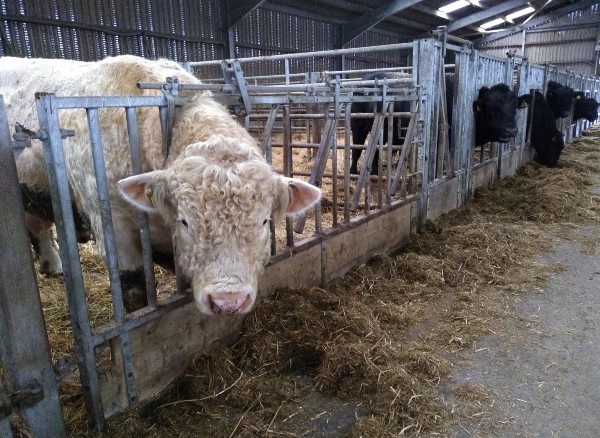Preparing for Winter Housing
6 November 2023Housing cattle ahead of winter is a key event in the farming calendar. A smooth transition at housing will ensure a healthy and productive winter. From ventilation to layout and bedding choice, the design and style of cattle housing has the potential to make a big difference to animal welfare and productivity.
It’s important not to forget the basics when preparing sheds for stock coming inside. Some key things to remember include:
- Have water troughs been cleaned out and are working effectively?
- Are feed passes and troughs clean?
- Have ventilation inlets and outlets have been checked?
- Have sheds and pens have been cleaned and disinfected?
- Check repairs have been carried out to internal gates.
For more information on the basics of getting sheds ready for housing please refer to Preparations Ahead of Housing Cattle and New Entrants – Preparing for Winter Housing.
Ventilation
Effective ventilation is key in cattle housing, to ensure good animal health and productivity. Ensuring good ventilation will reduce disease risk and provide a healthier atmosphere for stock. Also, well-ventilated buildings will ensure moisture is removed affectively from the air, reducing the amount of bedding required.
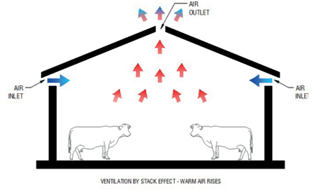
Improving ventilation in cattle sheds can improve productivity by 3-5% in beef cattle. Poorly ventilated buildings (usually older buildings) are often damp with very little fresh air circulating. In older buildings consider adjustments to improve air flow and ventilation such as adapting the sides of sheds, and air inlets and outlets to help improve ventilation. The effectiveness of ventilation requires significant inlet and outlet and stack effect. The ‘stack effect’ is where heat generated by the animals rises and escapes near the top of the building, e.g. from the ridge, and in turn this draws fresh air in lower down. For more information on the process of stack effect and ventilation in cattle housing please refer to this technical note and video.
Feed Space and Water Requirements
Feed space and water source are vital considerations for housing to minimise bullying and to ensure animals have sufficient drinking space and water quality. The following table gives minimum feeding space requirements for cattle depending on weight and feeding method.
| Mass of animal (kg) | Ration fed | Ad-lib fed |
|---|---|---|
| Feed barrier width (mm/animal) | Feed barrier width (mm/animal) | |
| 200 | 400 | 150 |
| 300 | 500 | 150 |
| 400 | 550 | 190 |
| 500 | 600 | 240 |
| 600 | 670 | 280 |
| 700 | 700 | 320 |
| 800 | 800 | 340 |
Feed barrier design can have a major impact on feed intakes and wastage of feed. The design will depend on animal size, group size and feed type/method. Although not possible in all systems, ideally barriers should give the flexibility for a range of cattle types and sizes i.e. cows and youngstock.
The cheapest and simplest barrier is two horizontal barriers (often traffic crash barriers) which cattle put their head through to eat. This type of barrier reduces the risk of heads potentially becoming stuck. Simple barrier designs with one bar or road crash barrier, can allow for more flexible feeding but also more wastage of feed being pulled through into the bedding area. When used with cows and young calves there is a chance that young calves can escape.
Diagonal feed barriers help to reduce bullying by restricting head movement while animals are eating and also help to reduce feed wastage.
Self-locking yokes are similar to an angle barrier and have the option of “locking” cattle in at the feed face. Restraining cattle at the feed face can allow access to the pen for scraping of passageways and routine handling, for example for pregnancy diagnosis, vaccinations and simply checking ear tags.
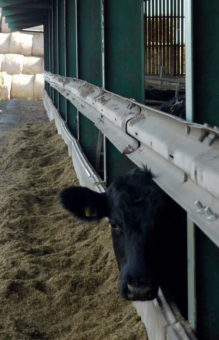
Look out for hair being rubbed off the necks of cattle, this is a sign that barriers are uncomfortable and need adjusting. The animal’s neck should not touch the top rail when feeding.
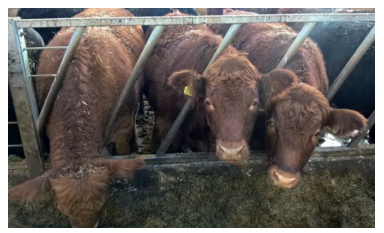
Stock must have access to clean, fresh drinking water at all times. It is important that troughs are sufficient for the number of cattle and the height of the trough is suitable for all ages of stock to be able to reach to drink from. Enough space should be available for 10% of the stock to drink at any time and flow rates to the troughs should be sufficient to cope with peak demands. It is advisable that the water trough/drinker is positioned so that is it easy to access for cleaning and maintenance. Ensure that water troughs are checked daily and cleaned out regularly as contaminated water (from faeces, feed dropped into troughs by cattle and other organic material) will reduce intakes and to reduce the risk of diseases such as Leptospirosis, Johne’s and E. coli, all of which can be spread by water contamination.
There are a number of factors which will affect an animal’s water consumption including diet and liveweight, but the following table gives an estimate of water requirements for cattle. Water flow rate can be measured by timing how long it takes to fill a litre of water - use this information to work out if there is enough flow in 24hours to meet the needs of the number of cattle in the pen.
| Stock Type | Estimated drinking water allowance (l/head/day) |
|---|---|
| Lactating suckler cows | 40 - 70 |
| Dry suckler cows | 14 - 40 |
| Growing cattle | 15 - 50 |
| Finishing cattle | 25 - 75 |
| Stock bull | 30 - 80 |
Lying Space
Lying space allowance for stock must be appropriate to the size of the animal, i.e. a weaned 6-month-old calf will not require the same space as a 500kg finishing animal. Space must allow for the animal to grow during the winter or period of housing. In-calf cows require additional space to allow for space for calving/the cow seeking isolation away from the rest of the group. Also remember when assessing space requirements for those with autumn calving cow herds, that space will be needed for a calf creep area.
The table below shows the minimum space allowance (for cattle courts). Note it is recommended that more space is allowed per animal for better welfare.
| Animal type | Space allowance | ||||
|---|---|---|---|---|---|
| Live weight (kg) | Solid Floors | Fully Slatted | |||
| Bedded Area | Total Area | ||||
| Suckler Cow & Calf (excluding creep area) | |||||
| 500 | 3.75 | 5.00 | 2.50 | ||
| 600 | 4.35 | 6.00 | 2.75 | ||
| 700 | 4.65 | 6.50 | 3.00 | ||
| 800 | 5.15 | 7.30 | 3.25 | ||
| Space allowance should be based on age, weight and behavioural needs of the stock, together with the size of the group | |||||
| Growing/Finishing Stock | 200 | 2.00 | 3.00 | 1.10 | |
| 300 | 2.75 | 3.95 | 1.50 | ||
| 400 | 3.50 | 4.90 | 1.80 | ||
| 500 | 4.25 | 5.85 | 2.10 | ||
| 600 | 5.00 | 6.80 | 2.30 | ||
| 700 | 5.75 | 7.75 | 2.50 | ||
Bedding Material
Housing stock on straw in straw-bedded courts is usual practice, providing a clean and comfortable bed providing enough dry straw is used and pens are not excessively stocked. Avoid bedding with wet straw, which has very little absorbency and is only around 10% as effective as dry straw in bedding stock. The addition of a scraped feed pass can help reduce straw bedding wastage.
This guide is full of useful advice on how to manage straw usage.
Young calves should have access to a creep / refuge area away from cows.
Straw availability and price has seen many farmers looking to bedding alternatives. There are a number of suitable alternative bedding materials available. For more information on these materials please refer to this factsheet.
Fully slatted courts are also an option for adult and weaned cattle. They allow for a higher stocking density (see previous table) and also remove the requirement for bedding. Calving cows require access to a bedded area and where young calves (less than one month) are housed on slats alongside cows they should have a non-slatted creep area.
There is also the option to house stock in cubicles, again reducing the requirement for bedding. It is important that the cubicles are correctly sized for the animal.
| Animal type | Space allowance | ||
|---|---|---|---|
| Liveweight (kg) | Length (m) | Width (m) | |
| Cows | 500 | 2.35 | 1.12 |
| 600 | 2.40 | 1.15 | |
| 700 | 2.50 | 1.18 | |
| 800 | 2.55 | 1.20 | |
| Growing/Finishing | 200 | 1.45 | 0.75 |
| 300 | 1.70 | 0.85 | |
| 400 | 2.05 | 1.05 | |
| 500 | 2.35 | 1.12 | |
| 600 | 2.40 | 1.15 | |
| 700 | 2.50 | 1.18 |
Bulls
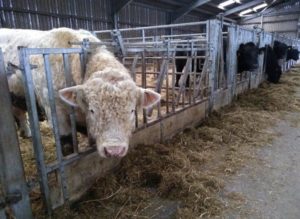 Ideally when bulls are not in use, they should be housed in bull pens. Many farms do not have suitable or dedicated bull pens and it is an area worth investing in to have a safe place for bulls and the ability to take them out of the cows to better manage the calving period.
Ideally when bulls are not in use, they should be housed in bull pens. Many farms do not have suitable or dedicated bull pens and it is an area worth investing in to have a safe place for bulls and the ability to take them out of the cows to better manage the calving period.
A few things to consider for bull pens;
- Ensure bulls are housed where they can still see stock.
- The pen should be well lit, with plenty space for the bull.
- If possible the pens should allow the bull to be fed and watered from outside the pen for safety.
- Consider self-locking yokes so bulls can be restrained to allow for bedding to be done without the need for physical contact.
- Ensure there is an escape route if you need to be in the pen with an unrestrained bull. Remember that all bulls can be unpredictable.
For further reading on livestock housing, please refer to the Beef Cattle Housing guide.
Sarah Balfour, SAC Consulting
Sign up to the FAS newsletter
Receive updates on news, events and publications from Scotland’s Farm Advisory Service

